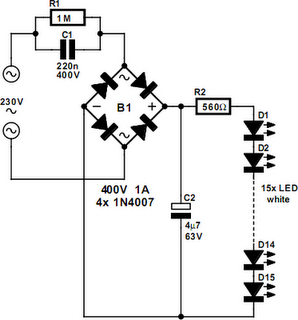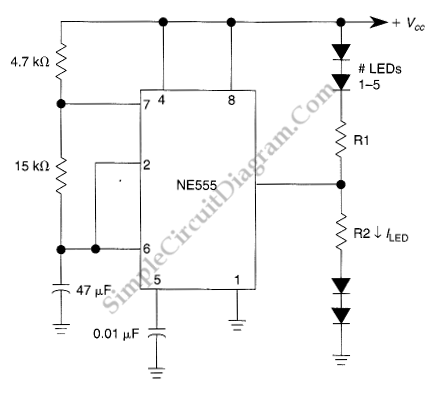
Mains Powered White LED Lamp

An array of white LEDs can serve as a compact lamp for living spaces. These LED lamps are commercially available and resemble standard halogen lamps, fitting into typical 230-V light fixtures. Upon inspection, it is evident that a capacitor is employed to reduce the voltage from 230 V to a level suitable for the LEDs. This approach is more cost-effective and compact than utilizing a transformer. The lamp consumes only 1 watt, resulting in lower light output compared to a 20 W halogen lamp, with a slightly bluer hue. The circuit operates as follows: C1 functions as a voltage-dropping resistor, maintaining the current at approximately 12 mA. A bridge rectifier converts the AC voltage to DC, as LEDs require a DC supply and can be damaged if the negative voltage exceeds 5 V. The electrolytic capacitor serves a dual purpose: it ensures adequate voltage to illuminate the LEDs when the mains voltage is below the forward voltage of the LEDs and mitigates the inrush current peak that occurs upon mains activation, which could otherwise harm the LEDs. Additionally, a 560-ohm resistor stabilizes the current through the LEDs, leading to a more uniform light output. The voltage drop across the 560-ohm resistor is 6.7 V, allowing 12 mA to flow through the LEDs, a safe current level. The total voltage drop across the LEDs, which are 15 in number at approximately 3 V each, amounts to about 45 V. The voltage across the electrolytic capacitor is slightly over 52 V. To understand the operation of C1, the impedance can be calculated using the formula: 1/(2 · f · C), resulting in approximately 14.4 kΩ. Multiplying this by 12 mA yields a voltage drop across the capacitor of 173 V. This setup functions effectively, as the combined voltage of 173 V from the capacitor and 52 V from the LEDs totals 225 V, which is close to the nominal mains voltage of 230 V. It is important to note that this calculation may not be entirely precise due to the non-sinusoidal nature of the actual mains voltage. For those in need of numerous white LEDs, purchasing one of these lamps and carefully breaking the bulb (with protective measures to contain glass shards) to salvage the LEDs can be a more economical option than buying individual LEDs.
The described LED lamp circuit utilizes a straightforward design that efficiently converts high-voltage AC mains power into a suitable DC voltage for LED operation. The C1 capacitor plays a critical role in voltage regulation, while the bridge rectifier ensures that the LEDs receive the necessary DC supply. The use of a resistor to stabilize current flow is essential for maintaining consistent brightness and preventing LED damage due to fluctuations in current. The careful selection of components, including the electrolytic capacitor and bridge rectifier, enhances the reliability and longevity of the lamp. Moreover, the option to repurpose LEDs from damaged lamps presents an economical alternative for those seeking to create custom lighting solutions. Overall, this circuit exemplifies a practical application of LEDs in home lighting, demonstrating both efficiency and innovation in electrical design.Did it ever occur to you that an array of white LEDs can be used as a small lamp for the living room If not, read on. LED lamps are available ready-made, look exactly the same as standard halogen lamps and can be fitted in a standard 230-V light fitting.
We opened one, and as expected, a capacitor has been used to drop the voltage from 230 V to the voltage suitable for the LEDs. This method is cheaper and smaller compared to using a transformer. The lamp uses only 1 watt and therefore also gives off less light than, say, a 20 W halogen lamp. The light is also somewhat bluer. The circuit operates in the following manner: C1 behaves as a voltage dropping resistor` and ensures that the current is not too high (about 12 mA). The bridge rectifier turns the AC voltage into a DC voltage. LEDs can only operate from a DC voltage. They will even fail when the negative voltage is greater then 5 V. The electrolytic capacitor has a double function: it ensures that there is sufficient voltage to light the LEDs when the mains voltage is less than the forward voltage of the LEDs and it takes care of the inrush current peak that occurs when the mains is switched on.
This current pulse could otherwise damage the LEDs. Then there is the 560-ohm resistor, it ensures that the current through the LED is more constant and therefore the light output is more uniform. There is a voltage drop of 6. 7 V across the 560- resistor, that is, 12 mA flows through the LEDs. This is a safe value. The total voltage drop across the LEDs is therefore 15 LEDs times 3 V or about 45 V. The voltage across the electrolytic capacitor is a little more than 52V. To understand how C1 functions, we can calculate the impedance (that is, resistance to AC voltage) as follows: 1/(2 ·f ·C), or: 1/ (2 ·3.
14 ·50 ·220 ·10-9)= 14k4. When we multiply this with 12 mA, we get a voltage drop across the capacitor of 173 V. This works quite well, since the 173-V capacitor voltage plus the 52-V LED voltage equals 225 V. Close enough to the mains voltage, which is officially 230 V. Moreover, the latter calculation is not very accurate because the mains voltage is in practice not quite sinusoidal. Furthermore, the mains voltage from which 50-V DC has been removed is far from sinusoidal. Finally, if you need lots of white LEDs then it is worth considering buying one of these lamps and smashing the bulb with a hammer (with a cloth or bag around the bulb to prevent flying glass!) and salvaging the LEDs from it.
This can be much cheaper than buying individual LEDs 🔗 External reference
The described LED lamp circuit utilizes a straightforward design that efficiently converts high-voltage AC mains power into a suitable DC voltage for LED operation. The C1 capacitor plays a critical role in voltage regulation, while the bridge rectifier ensures that the LEDs receive the necessary DC supply. The use of a resistor to stabilize current flow is essential for maintaining consistent brightness and preventing LED damage due to fluctuations in current. The careful selection of components, including the electrolytic capacitor and bridge rectifier, enhances the reliability and longevity of the lamp. Moreover, the option to repurpose LEDs from damaged lamps presents an economical alternative for those seeking to create custom lighting solutions. Overall, this circuit exemplifies a practical application of LEDs in home lighting, demonstrating both efficiency and innovation in electrical design.Did it ever occur to you that an array of white LEDs can be used as a small lamp for the living room If not, read on. LED lamps are available ready-made, look exactly the same as standard halogen lamps and can be fitted in a standard 230-V light fitting.
We opened one, and as expected, a capacitor has been used to drop the voltage from 230 V to the voltage suitable for the LEDs. This method is cheaper and smaller compared to using a transformer. The lamp uses only 1 watt and therefore also gives off less light than, say, a 20 W halogen lamp. The light is also somewhat bluer. The circuit operates in the following manner: C1 behaves as a voltage dropping resistor` and ensures that the current is not too high (about 12 mA). The bridge rectifier turns the AC voltage into a DC voltage. LEDs can only operate from a DC voltage. They will even fail when the negative voltage is greater then 5 V. The electrolytic capacitor has a double function: it ensures that there is sufficient voltage to light the LEDs when the mains voltage is less than the forward voltage of the LEDs and it takes care of the inrush current peak that occurs when the mains is switched on.
This current pulse could otherwise damage the LEDs. Then there is the 560-ohm resistor, it ensures that the current through the LED is more constant and therefore the light output is more uniform. There is a voltage drop of 6. 7 V across the 560- resistor, that is, 12 mA flows through the LEDs. This is a safe value. The total voltage drop across the LEDs is therefore 15 LEDs times 3 V or about 45 V. The voltage across the electrolytic capacitor is a little more than 52V. To understand how C1 functions, we can calculate the impedance (that is, resistance to AC voltage) as follows: 1/(2 ·f ·C), or: 1/ (2 ·3.
14 ·50 ·220 ·10-9)= 14k4. When we multiply this with 12 mA, we get a voltage drop across the capacitor of 173 V. This works quite well, since the 173-V capacitor voltage plus the 52-V LED voltage equals 225 V. Close enough to the mains voltage, which is officially 230 V. Moreover, the latter calculation is not very accurate because the mains voltage is in practice not quite sinusoidal. Furthermore, the mains voltage from which 50-V DC has been removed is far from sinusoidal. Finally, if you need lots of white LEDs then it is worth considering buying one of these lamps and smashing the bulb with a hammer (with a cloth or bag around the bulb to prevent flying glass!) and salvaging the LEDs from it.
This can be much cheaper than buying individual LEDs 🔗 External reference
Warning: include(partials/cookie-banner.php): Failed to open stream: Permission denied in /var/www/html/nextgr/view-circuit.php on line 713
Warning: include(): Failed opening 'partials/cookie-banner.php' for inclusion (include_path='.:/usr/share/php') in /var/www/html/nextgr/view-circuit.php on line 713





